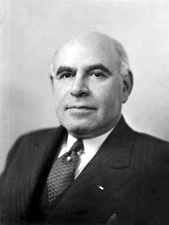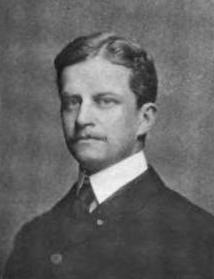Life
He was born on March 12, 1900, in Williamsburg, Brooklyn. He graduated from Brooklyn Law School, and practiced law in New York City.

Williamsburg is a neighborhood in the New York City borough of Brooklyn, bordered by Greenpoint to the north; Bedford–Stuyvesant to the south; Bushwick and East Williamsburg to the east; and the East River to the west. As of the 2010 United States Census, the neighborhood's population is 32,926.

Brooklyn Law School (BLS) is a private law school in New York City. Founded in 1901, it has approximately 1,100 students. Brooklyn Law School's faculty includes 60 full-time faculty, 15 emeriti faculty, and a number of adjunct faculty.

The City of New York, usually called either New York City (NYC) or simply New York (NY), is the most populous city in the United States. With an estimated 2017 population of 8,622,698 distributed over a land area of about 302.6 square miles (784 km2), New York is also the most densely populated major city in the United States. Located at the southern tip of the state of New York, the city is the center of the New York metropolitan area, the largest metropolitan area in the world by urban landmass and one of the world's most populous megacities, with an estimated 20,320,876 people in its 2017 Metropolitan Statistical Area and 23,876,155 residents in its Combined Statistical Area. A global power city, New York City has been described as the cultural, financial, and media capital of the world, and exerts a significant impact upon commerce, entertainment, research, technology, education, politics, tourism, art, fashion, and sports. The city's fast pace has inspired the term New York minute. Home to the headquarters of the United Nations, New York is an important center for international diplomacy.
Schwartzwald was a member of the New York State Assembly (Kings Co., 6th D.) in 1927, 1928, 1929, 1930, 1931, 1932 and 1933.

The New York State Assembly is the lower house of the New York State Legislature, the New York State Senate being the upper house. There are 150 seats in the Assembly, with each of the 150 Assembly districts having an average population of 128,652. Assembly members serve two-year terms without term limits.

The 150th New York State Legislature, consisting of the New York State Senate and the New York State Assembly, met from January 5 to March 25, 1927, during the fifth year of Al Smith's second tenure as Governor of New York, in Albany.

The 151st New York State Legislature, consisting of the New York State Senate and the New York State Assembly, met from January 4 to March 22, 1928, during the sixth year of Al Smith's second tenure as Governor of New York, in Albany.
He was a member of the New York State Senate (7th D.) from 1935 to 1942, sitting in the 158th, 159th, 160th, 161st, 162nd and 163rd New York State Legislatures.

The New York State Senate is the upper house of the New York State Legislature. There are 63 seats in the Senate, and its members are elected to two-year terms. There are no term limits.

The 158th New York State Legislature, consisting of the New York State Senate and the New York State Assembly, met from January 2 to April 17, 1935, during the third year of Herbert H. Lehman's governorship, in Albany.

The 159th New York State Legislature, consisting of the New York State Senate and the New York State Assembly, met from January 1 to May 13, 1936, during the fourth year of Herbert H. Lehman's governorship, in Albany.
On September 9, 1942, he was appointed by Gov. Herbert H. Lehman to the City Court, to fill the vacancy caused by the death of Edward J. Kelly. [1] In November 1942, he was elected to a full ten-year term, [2] and was re-elected in November 1952.

Herbert Henry Lehman was a Democratic Party politician from New York. He served from 1933 until 1942 as the 45th Governor of New York and represented New York State in the US Senate from 1949 until 1957.
On November 2, 1954, he was elected to the New York Supreme Court for a 14-year term beginning on January 1, 1955. [3] On November 20, 1954, six weeks before his term would begin, he was appointed by Gov. Thomas E. Dewey to the Supreme Court, to fill a vacancy. [4] He was re-elected in November 1968, became an Official Referee (i.e. a senior judge on an additional seat) of the Supreme Court in 1971, and retired from the bench at the end of 1976 when he reached the constitutional age limit.
The Supreme Court of the State of New York is the trial-level court of general jurisdiction in the New York State Unified Court System. It is vested with unlimited civil and criminal jurisdiction, although outside New York City it acts primarily as a court of civil jurisdiction, with most criminal matters handled in County Court.

Thomas Edmund Dewey was an American lawyer, prosecutor, and politician. He served as the 47th Governor of New York from 1943 to 1954. In 1944, he was the Republican Party's nominee for President. He lost the 1944 election to President Franklin D. Roosevelt in the closest of Roosevelt's four presidential elections. He was again the Republican presidential nominee in 1948, but lost to President Harry S. Truman in one of the greatest upsets in presidential election history. Dewey played a large role in winning the Republican presidential nomination for Dwight D. Eisenhower in 1952, and helped Eisenhower win the presidential election that year. He also played a large part in the choice of Richard M. Nixon as the Republican vice-presidential nominee in 1952 and 1956.
He died on October 8, 1983, in Interfaith Hospital in Brooklyn. [5]
This page is based on this
Wikipedia article Text is available under the
CC BY-SA 4.0 license; additional terms may apply.
Images, videos and audio are available under their respective licenses.

The 1974 New York state election was held on November 5, 1974, to elect the Governor, the Lieutenant Governor, the State Comptroller, the Attorney General, two judges of the New York Court of Appeals and a U.S. Senator, as well as all members of the New York State Assembly and the New York State Senate.

The 1946 New York state election was held on November 5, 1946, to elect the Governor, the Lieutenant Governor, the State Comptroller, the Attorney General, a U.S. Senator, the Chief Judge and an associate judge of the New York Court of Appeals, as well as all members of the New York State Assembly and the New York State Senate.
Edmund Harris Lewis was an American lawyer and politician from New York. He was Chief Judge of the New York Court of Appeals from 1953 to 1954.
Albert Conway was an American lawyer and politician from New York. He was Chief Judge of the New York Court of Appeals from 1955 to 1959.
Charles David Breitel was an American lawyer and politician from New York. He was Chief Judge of the New York Court of Appeals from 1974 to 1978.

Chester Bentine McLaughlin was an American lawyer and politician from New York.

Edward Ridley Finch was an American lawyer and politician.

The 1943 New York state election was held on November 2, 1943, to elect the Lieutenant Governor and a judge of the New York Court of Appeals.

The 1949 New York state election was held on November 8, 1949, to elect a judge of the New York Court of Appeals and a U.S. Senator.

The 1953 New York state election was held on November 3, 1953, to elect the Chief Judge of the New York Court of Appeals. Besides, nine amendments to the State Constitution, among them one that required the voter to cast a single joint vote for the candidates for Governor and Lieutenant Governor on any ticket, were proposed, and all were accepted by the electorate.
John H. Van Voorhis was an American lawyer and politician.

The 1960 New York state election was held on November 8, 1960, to elect two judges of the New York Court of Appeals, as well as all members of the New York State Assembly and the New York State Senate.
Doris Irene Byrne was an American lawyer and politician from New York. She was the first woman justice of the New York City Court of Special Sessions, appointed in 1950.
Benjamin Brenner was an American lawyer and politician from New York.
Perry Belmont Duryea was an American businessman and politician from New York.
Louis L. Friedman was an American lawyer and politician from New York.
Paul D. Graves was an American lawyer and politician from New York.

The 169th New York State Legislature, consisting of the New York State Senate and the New York State Assembly, met from January 7, 1953, to June 10, 1954, during the eleventh and twelfth years of Thomas E. Dewey's governorship, in Albany.
Frank Composto was an American lawyer and politician from New York.

The 177th New York State Legislature, consisting of the New York State Senate and the New York State Assembly, met from January 4, 1967, to May 25, 1968, during the ninth and tenth years of Nelson Rockefeller's governorship, in Albany.










